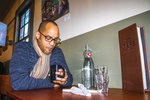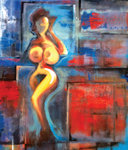Growing up in Brooklyn during the 1960s and 1970s as an African American, Gullah/Geechee Creole and Jew, it is no surprise Sequoyah Rodriguez experienced first-hand racism.
This item is available in full to subscribers.
We have recently launched a new and improved website. To continue reading, you will need to either log into your subscriber account, or purchase a new subscription.
If you had an active account on our previous website, then you have an account here. Simply reset your password to regain access to your account.
If you did not have an account on our previous website, but are a current print subscriber, click here to set up your website account.
Otherwise, click here to view your options for subscribing.
* Having trouble? Call our circulation department at 360-385-2900, or email our support.
Please log in to continue |
|


Growing up in Brooklyn during the 1960s and 1970s as an African American, Gullah/Geechee Creole and Jew, it is no surprise Sequoyah Rodriguez experienced first-hand racism.
What is a surprise, he said, is such racism can still be found decades later even here in Jefferson County.
“I recently read in The Leader, people are writing letters to the editor who are defending nooses being hung here in the community,” Rodriguez said. “It was Quilcene, but that is close enough. I have had two famly members lynched. That is not a whole lot of progress and is being defended.”
Unfortunately, such situations seem to always be present no matter where in the country Rodriguez finds himself, he said, adding that how he reacts to such situations unintentionally ends up in his acrylic paintings.
“It creeps out unwittingly sometimes in some things I do because it is something I have to deal with and have to be concerned about and I shouldn’t. It is 2019 and I really thought we would be done with this sort of thing. In terms of identity and what have you, yeah, it’s a pain in the a**. How do you articulate that artistically? I don’t know. I am still trying to work that out.”
Rodriguez and David Bellecci are featured in the fall Art in Gathering Places exhibits at Fort Worden.
Rodriguez’ modernist landscapes and figures are on display at Taps at the Guardhouse. Bellecci’s contemporary acrylics are on display at Reveille at the Commons.
Native New Yorker
Rodriguez is a figurative painter, sculptor and playwright. The first-born of an ethnically mixed
and dual-culture working-class couple in New York City, he lived in or near the Crown Heights section of Brooklyn for most of his life.
“The thing about Brooklyn is you know where the dividing line is between your neighborhood and someplace else,” Rodriguez said.
That wasn’t to say friendships didn’t develop across turf lines.
But if they did, “you guys had to meet at school on a Saturday. It happened and it is going to happen. People are not going to completely cut themselves off like that.”
Rodriguez said his work is an homage to distinctive moments from his childhood.
“I appreciated the clarity of things back then. Things are very confusing and irrational right now.”
One piece in particular is of him as a young boy peeking around the corner of a door into a live drawing room where a nude woman is being drawn, he said.
Other memories, which may or may not come through in his paintings, include the unique ethnic status Rodriguez represented.
His father, a Gullah/Geechee Creole, was born and raised in Moncks Corner, South Carolina.
“Gullah history, the way it is, we have our own language. We have our own spiritual systems. We have our own culture, but one of the reasons for that is because during the slavery period we were cut off. We had owners but they didn’t come out very much because of the conditions. There were mosquitoes, people often had a hard time and Europeans often had a hard time surviving.”
The only other residents there were Native Americans, Rodriguez said.
“There was a lot of trade in terms of knowledge and intermarriage. Within the black world, we are still somewhat separate. It is kind of like in the Jewish world where you have Ashkenazi Jews, which I am, but also Mizrahi Jews and Sephardi Jews which don’t really intermingle. We still have separate synagogues. Even in the black community I have that separateness.”
It was Rodriguez’s mother who was Jewish, he said.
“Being on a school bus with a group of black and Latino children, primarily, and sitting there while they are sieg heiling a group of Hasidic Orthodox Jews on their way to synagogue and I am just sitting there? Yeah. That is kind of bad. Not knowing what to say and then going home and telling my mother.”
Even though he was dealing with racism in an undercover manner, Rodriguez is not one to complain.
“It was difficult but I don’t want to whine about it because a lot of people have it and have had it way worse,” he said. “I have dealt with discrimination and it was bad and still bothers me and comes out sometimes in my work.”
The son of a draughtsman and portraitist, Rodriguez’ artistic training began early under his father’s tutelage and he attained recognition in school, leading to awards and a one-man show of his architectural drawings.
“My father was an artist, too,” Rodriguez said. “He wasn’t famous. He wasn’t able to make it because of the racism of the time and in a lot of ways he taught me to do the things he wasn’t allowed to do.”
Rodriguez later attended the vocational High School of Art and Design in Manhattan, where the rigorous commercial art curriculum, the international student body and cosmopolitan atmosphere of creative sharing began to shape him as an artist.
“I was also inspired by the fact that pop-art icon Andy Warhol would often stroll past the school to observe what we were coming up with,” Rodriguez said.
After college, Rodriguez spent many years dividing his time between navigating his city’s diverse subcultural landscape and struggling to earn a living through a long series of dead-end, often unpaid menial jobs, he said.
Without much money to live on, Rodriguez couldn’t afford art supplies.
“When you don’t have money to get materials, you can’t work. If you can’t work you can’t even consider looking for a market to even sell. I would go in between writing and artwork, sometimes trying to do both.”
After finally securing employment in civil service, Rodriguez said his creativity came and went until recently when he decided to create an artistic record of his memoirs as an existential testimony to his surviving family members and to his friends.
“It is by complete accident—and to my own embarrassment—that emotion comes through in my work, as I always consciously fight against this. And generally, I only come to understand what I was feeling while constructing a piece, long after I have finished it and stepped away from what I have done.”
The paintings ultimately are a reflection of Rodriguez’s inner being, he said.
“In this sense, what you see on canvas is really me, being candid about myself and my thoughts without using words. I stress this because in truth, I draw, paint and write so that I may be understood without having to speak. Leaving my deeper meanings or messages to be discerned by those who are sincerely interested in looking for them at their convenience.”